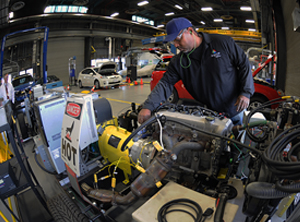Battery power
Argonne gives the United States a jolt in the global race to create the best hybrid-electric car power source.
By Kate Silver
Photography by Dan Dry

Argonne's cathode material technology is driving US battery manufacturing momentum.
The United States has competed for years with Asian and European countries to produce the most advanced battery to power plug-in hybrid-electric vehicles. It is an intense competition in a market that could be a $100 billion-a-year business by 2030.
In January Argonne National Laboratory announced two agreements that signaled a step forward for the United States in the global advanced-battery race: the lab licensed its battery technology to General Motors Co. and LG Chem. The moves were also a victory for Argonne, which is owned by the US Department of Energy and managed by the University of Chicago.
Automobile-battery research and development has been a priority at Argonne for more than four decades—since the Arab oil embargo sparked a quest for better car batteries and optimized energy storage. For the past 15 years, Argonne’s focus has been on lithium-ion batteries. “The way technology innovation really occurs is there are ‘aha’ moments,” says Jeff Chamberlain, who heads Argonne’s Energy Storage Initiative. “But in terms of wrangling an ‘aha’ moment into technology that ends up in yours and my hands, that’s usually a five- to 20-year process.”
Argonne’s patented cathode material technology was one such “aha” moment that has successfully navigated the long process scientists often refer to as the “valley of death.” The technology is now used in lithium-ion cells made by LG Chem to power GM’s Chevrolet Volt, an electric car that has an EPA-estimated range of 35 miles on a full charge and was named 2011 North American Car of the Year. Throughout this year the Volt, which had a limited release in December, will be rolled out around the United States.
To make the cathode technology viable for the Volt, Argonne made some improvements. Using lithium-rich and manganese-rich materials, the lab created a less expensive and more stable design, meaning it’s less likely to overheat.
General Motors also plans to use Argonne’s cathode material technology as it builds next-generation batteries. The company hopes to create a longer-lasting, safer battery that can charge at higher voltages than others on the market. The new cathode could increase the energy-storage capacity of the battery 50 to 100 percent.
The LG Chem and GM licensing agreements illustrate the momentum of America’s emerging battery-manufacturing industry. President Barack Obama announced in 2009 that the Recovery Act would fund nearly $2.4 billion in grants to support battery development and electric-vehicle innovation. The funds have led to several new battery-producing factories, including LG Chem’s $303 million facility in Holland, Michigan, which received a $151.3 million grant from the DOE and which will employ an estimated 450 workers.
It’s a big change from the past two decades, when the majority of lithium-ion batteries were manufactured in Asia. “US companies didn’t pursue [the battery industry] that aggressively, mainly because it was used for portable electronics, laptops, and cell phones, and all that production has really gone over to Asia,” says Andrew Jansen, principal electrochemical engineer at Argonne.
But as the hybrid-electric-vehicle industry has grown, it’s become clear that if the United States is going to make advanced-battery cars to rival the Toyota Prius, Nissan Leaf, and others, it ought to have a stake in next-generation batteries. “What’s holding back transportation is a decent battery,” says Jansen. “A high-energy, long-life, low-cost battery.”
Argonne’s eventual goal is to create a battery that lasts ten years, costs less than $10,000, and yields 200 to 250 miles per charge with enough power for a four-door sedan. The timeline for such a battery is far off, says Michael Thackeray, a group leader and distinguished fellow in Argonne’s battery-technology department: “It’s going to be a stretch”—possibly 20 years or more. “There’s a trade-off between the energy, the power, the volume, and the mass of the battery. The big thing is to make batteries as energetic as possible, and as light as possible, and as small as possible so we can go 200 miles on a single charge. And that is not what we’ve got at the moment.”
Of course, that battery isn’t just Argonne’s goal. Scientists across the globe are competing to outdo one another. “It is a very vigorous, well-fought, aggressive competition around the world, both in academic circles and industrial circles, but I think more importantly in the national realm,” says Chamberlain. “All of these nations look at it as a way to have an economic boom.”
Return to top
